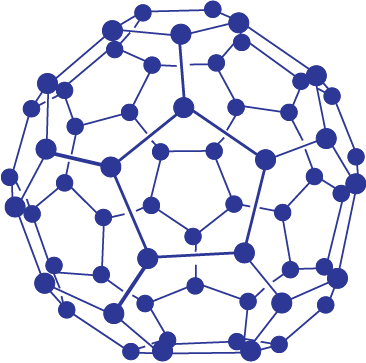Fullerenes are made by the heating of graphite in an electric arc in the presence of inert gases such as helium or argon. The sooty material formed by condensation of vapourised Cn small molecules consists of mainly C60 with smaller quantity of C70 and traces of fullerenes consisting of even number of carbon atoms up to 350 or above. Fullerenes are the only pure form of carbon because they have smooth structure without having ‘dangling’ bonds. Fullerenes are cage like molecules. C60 molecule has a shape like soccer ball and called Buckminsterfullerene (Fig. 11.5).
It contains twenty six- membered rings and twelve five-membered rings. A six membered ring is fused with six or five membered rings but a five membered ring can only fuse with six membered rings. All the carbon atoms are equal and they undergo sp2 hybridisation. Each carbon atom forms three sigma bonds with other three carbon atoms. The remaining electron at each carbon is delocalised in molecular orbitals, which in turn give aromatic character to molecule. This ball shaped molecule has 60 vertices and each one is occupied by one carbon atom and it also contains both single and double bonds with C–C distances of 143.5 pm and 138.3 pm respectively. Spherical fullerenes are also called bucky ballsin short.

Fig.11.5 The structure of C60, Buckminster-fullerene : Note that molecule has the shape of a soccer ball (football).
It is very important to know that graphite is thermodynamically most stable allotrope of carbon and, therefore, ∆f H of graphite is taken as zero. ∆f H values of diamond and fullerene, C60 are 1.90 and 38.1 kJ mol–1, respectively.
Other forms of elemental carbon like carbon black, coke, and charcoal are all impure forms of graphite or fullerenes. Carbon black is obtained by burning hydrocarbons in a limited supply of air. Charcoal and coke are obtained by heating wood or coal respectively at high temperatures in the absence of air.

© 2025 GoodEd Technologies Pvt. Ltd.